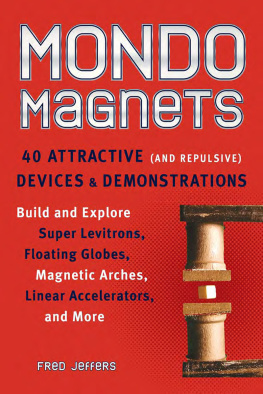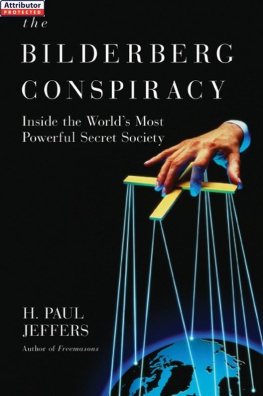
Library of Congress Cataloging-in-Publication Data
Jeffers, Fred.
Mondo magnets : 40 attractive (and repulsive) devices and demonstrations / Fred Jeffers.
p. cm.
ISBN-13: 978-1-55652-630-5
ISBN-10: 1-55652-630-X
1. MagnetismExperimentsPopular works. 2. MagneticsExperimentsPopular works. I. Title.
QC753.5.J44 2007
538.078dc22
2006026498
Cover design: Monica Baziuk
Interior design: Rattray Design
Interior illustrations: Michael Rattray
All photos courtesy of the author except page , which is courtesy of Fred Chamberlain.
2007 by Fred Jeffers
All rights reserved
Published by Chicago Review Press, Incorporated
814 North Franklin Street
Chicago, Illinois 60610
ISBN-10: 1-55652-630-X
ISBN-13: 978-1-55652-630-5
Printed in the United States of America
5 4 3 2 1
Contents
Introduction
W elcome to the wondrous world of magnetism! When I was a small child I was given a pair of toyssmall magnetic Scottie dogsto play with. I have been fascinated by magnetism ever since. I was recently delighted to find that, after more than 60 years, the magnetic toy dogs are still sold today (they can be found at www.lehmans.com).

Magnetic Scottie dogs
During my 38-year career in industrial magnetic product research I have developed, discovered, and elaborated on many remarkable magnetic physics demonstrations, or magic tricks. Each is based on real magnetic physics, and they all produce surprising and seemingly impossible effects.
I presented some of these demonstrations in a series of Magnetic Magic Show lectures after I was named an IEEE (Institute for Electrical and Electronic Engineering) Distinguished Lecturer in 1999. The lectures were so successful, with a total of more than 3,000 people attending my shows, that I was motivated to write down the demonstrations in the form of this book.
These experiments illustrate and bring to life important concepts in the very poorly understood field of magnetism. Many of the effects demonstrated at first baffle even magnetic experts, to the extent that they appear to be magic. However, to paraphrase Arthur C. Clarke, magic is just a word that means technology we dont understand yet. This book shows how each of these 40 mesmerizing tricks works; once the secrets are revealed, the explanations of the magic involved are relatively simple to understand. Enjoy!
Experiment 1
Magnetic Money, Rocks, Beach Sand, Total Cereal, and Dirt
Its shown that money, many rocks, beach sand, Total cereal, and even common dirt are magnetic.
Materials
U.S. $1 bill
Cellophane tape
Very strong magnet (such as an NdFeB magnet)
Rock (see page )
Several handfuls dry beach sand
Two small, nonmagnetic jars (such as glass baby food jars) and their lids
Several handfuls Total cereal
Medium-sized bowl
Pestle or heavy spoon
Several handfuls dirt

Elements of magnetic money, rocks, beach sand, Total cereal, and dirt
Fold the $1 bill tightly into a roughly -inch square and hold it together with cellophane tape, as shown. Show that the $1 bill is attracted to the strong magnet.

Magnetic money
Next, show that the rock can be suspended under the magnet. You will need to find a suitable rock before you beginnot all rocks are attracted to a strong magnet. Go to a beach or a streambed or anywhere where there is a large variety of rocks, touch your strong magnet to different small stones, and in a short time you should be able to find one that will work for this demonstration.

Magnetic rock
Place a large handful of beach sand in one of the jars and secure the lid. Turn the jar upside down and tape the magnet to its bottom. Shake the jar briskly for a few minutes, then remove the lid and slowly pour out the sand. A tablespoon or so of coarse, strongly magnetic black powder will remain in the jar, attracted to the magnet.

Magnetic beach sand
Remove the magnet from the jar and pour the black powder into another small jar for safekeeping. Using the same sand, repeat the procedure a few times to separate a bit more magnetic material from the sand. Transfer the black magnetic powder to the other small jar and set aside.
Using additional handfuls of sand, repeat the process, transferring the black magnetic powder thats collected to the second jar as you go. (This powder can be used to make a crude but effective Magnetic Mountain demonstration, which is described in .)
Place a large handful of cereal in the bowl and, using the pestle or spoon, grind it into a very fine powder. Pour the powdered cereal into one of the jars and secure the lid. Turn the jar upside down, tape the magnet to the bottom of the jar, and briskly shake the jar for a few minutes. Remove the lid and slowly pour out the powdered cereal. About a teaspoon of magnetic material will remain inside, attracted to the magnet. You may have to repeat this process a few times, using new bowls of cereal, to collect a significant amount of magnetic material. Shown on page is a small amount of magnetic cereal matter suspended in a plastic bag.

Magnetic Total cereal
Finally, take a few handfuls of ordinary dirt from the garden and refine it in the same manner as for sand. This photo shows the jar of magnetic dirt suspended below the magnet.

Magnetic dirt
The Science Behind It
Why are all these things magnetic?
In each case, the black magnetic material thats collected is iron oxide. Iron is the fourth most abundant element in the earths crust. The most abundant iron oxide is black Fe3O4, which is strongly magnetic. A $1 bill is magnetic because the black ink on the portrait side of the bill is loaded with black iron oxide Fe3O4 pigment. The bill contains only about 5 mg of the oxide. The bill weighs almost exactly 1 gm, so the Fe3O4 present in the pigment is easily holding up more than 200 times its own weight! This Fe3O4 pigment was originally put in the ink to make it black, not to make it magnetic. The hysteresis loop of a $1 bill is shown below. The coercivity is about 100 Oe and the remanent moment is appreciable.

Hysteresis loop of a $1 bill
Next page

















